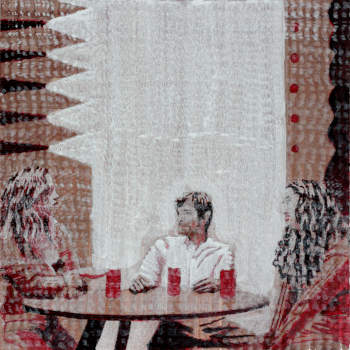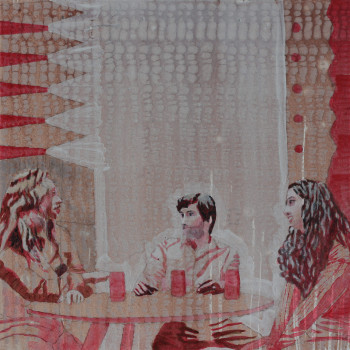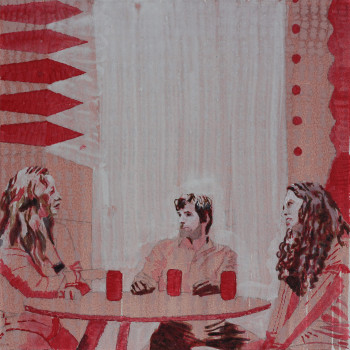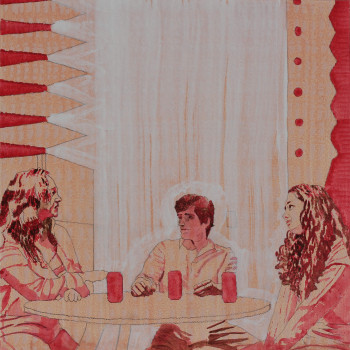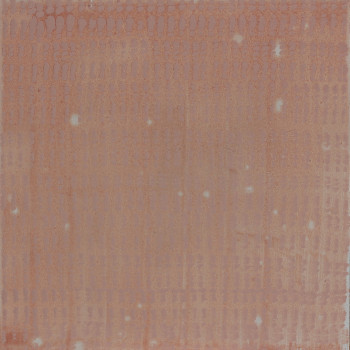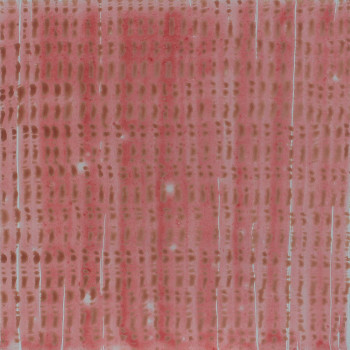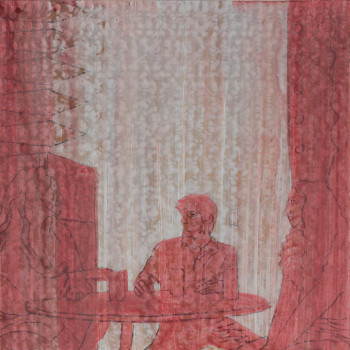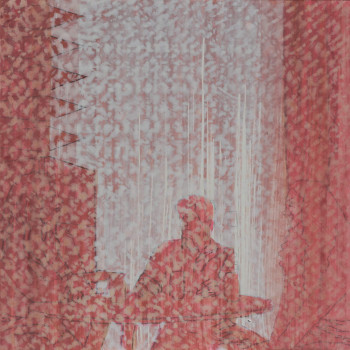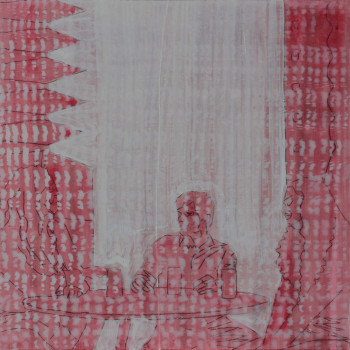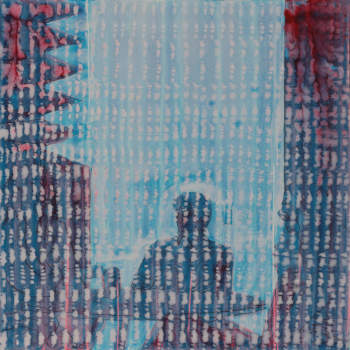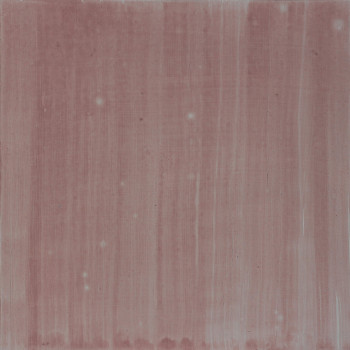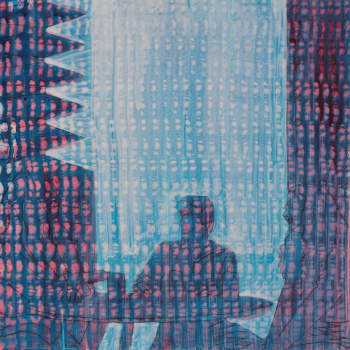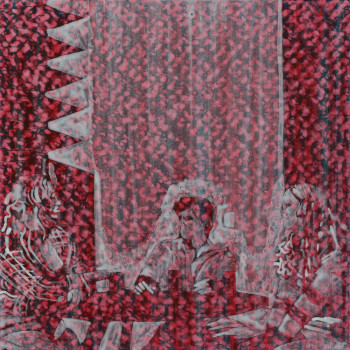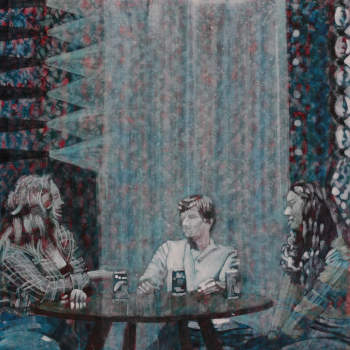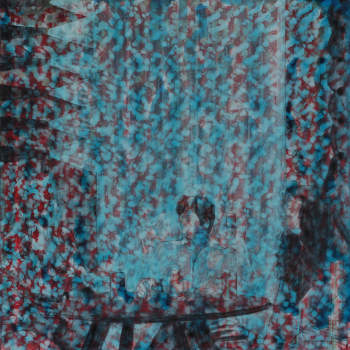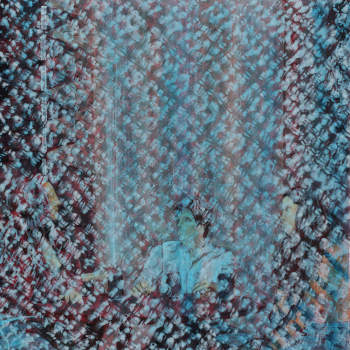This body of work explores the slippery terrain between perception, memory, and meaning, unfolding across a sequence of painterly images that resemble stills from a film yet remain uncaptured by any cinematic frame. Each piece offers a layered surface — not only of paint, but of thought, language, and spiritual reckoning.
The recurring motif of three figures seated at a table becomes an anchor point through which shifting emotions, symbolic relationships, and socio-political undercurrents pass. Though the figures recur, they are never quite the same. Repetition becomes a site of difference, echoing theological, psychological, and cultural processes of becoming. They are drawn from life but distorted through intuition, dream logic, and painterly accident.
A journal accompanies each image — often poetic, sometimes abrasive, sometimes transcendent — functioning not as explanation but as part of the artwork’s unfolding. These texts provide a porous threshold between image and viewer, revealing the artist's struggle to name what resists naming. Language itself is examined, dismantled, and reassembled — at times through pun, at times through theological musing or political lament.
The surfaces are frequently interrupted — by cascading vertical lines, glaze, or layers of “mocha mousse” earth tones — introducing a visual palimpsest that mirrors the fragmentation of consciousness. Patterns repeat, shift, and dissolve. Themes of division and longing emerge: East and West, faith and doubt, male and female, surface and depth, communion and estrangement.
As a whole, the series resists closure. There is no resolution, only the ongoing gesture — of looking, naming, failing, painting, watching. The tension between the sacred and the profane is palpable, as is a yearning for unity that never quite arrives. The works seem to ask: How do we perceive what is eternal in the flicker of the everyday? And what ghosts sit at our tables, uninvited but unavoidable?
27 June 2025
When I was just a little boy, I had a dream where a deep and gravelly voice said, “come to me.” Out on the pagoda (we call it that anyway), my mom was there, but she could not see or hear me — she just stared eternally ahead of her, unmoving. I felt that the voice belonged to Satan. It sounded like a voice from a horror movie, or something evil I had seen on TV, so I answered firmly: “No!” It is the only dream that I still remember from boyhood — I must have been around seven. For that reason it must be an important dream, something more than just a secular psychological construction.
To my aesthetic at the time, I did not recognise the voice as God’s, and I remember an intense, overwhelming feeling of terror — one of the reasons I did not forget it. It is the earliest dream I can recall. It was what we call a “nightmare,” which, by the way, has Celtic pagan roots. And I know now that terror can certainly be divine in origin.
My sheep hear my voice. (They recognise the voice and who it belongs to. One’s aesthetic — how the information we absorb and our minds engage in a dynamic process to construct an image of reality — is critical in recognising persons and voices.)
Did I have the aesthetic as that young boy capable of recognising the voice of God if I heard it? I wonder — if I heard that same voice now, would I still reject it? Or would my aesthetic value it, recognise it as God’s voice?
Thinking about this dream, it feels as if You are telling me that much of what I once thought good is evil, and vice versa. The process of re-evaluating — based on a more developed aesthetic, through study and life experience — is going to turn many things upside down. Or rather, more the right way up!
The young, pure, uncorrupted Samuel also failed to recognise God’s voice when he first heard it. Eli eventually figured out what was happening, even though the years had rendered him old, obese, and weak in disciplining his sons. Even though Eli was not perfect, he was able to set Samuel on his ordained path.
Imagine if no one listened to Eli — because of his faults, because of his depravity — and cancelled him as having nothing to offer, disregarding him as a fool. Now that would be foolish indeed.
2 July 2025
This series seems like it is still in its construction phase — a work in progress, incomplete. When laid out in a four-by-four grid in the order I painted them, it seems fragmented. There is no gradual fade of colour that would unite the series, and even the repeated image is not present in all of them.
It does not strike me as beautiful in an overwhelming way, but rather like posters at various stages of decomposition stuck on an urban wall — posters advertising a play that has long ago ceased running, maybe. Careless, messy, fast, cheap. And that creates ennui, a sublime feeling of tragedy, with the content, with the represented figures engaged in a conversation around a table, as if they were persons who exist by enormous effort — all that wasted effort — because they will cease to be.
They look so engaged in whatever it is that they are doing, as if it was so important to them while they were doing it, all their apparatus bent on collecting the eleven million bits of data per second. I get a sense of modern brutalism. Something much larger running roughshod over them. The figures recede and sometimes even disappear — at the mercy of the larger movement that did not seem to take enough care to determine them.
The emotion that is produced is so hard for me to describe, yet it feels poignant somehow. These poor souls consuming Coca-Cola, running after their artificially constructed desires. Acting as human shields for this larger movement, perhaps, being used. These paintings give me a sense that they were painted long ago — that once there were three people sitting around a table in a room with a waterfall.
